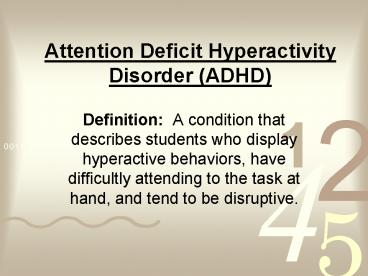Attention Deficit Hyperactivity Disorder (ADHD) - PowerPoint PPT Presentation
1 / 22
Title:
Attention Deficit Hyperactivity Disorder (ADHD)
Description:
Definition: A condition that describes students who display hyperactive ... Impairment of verbal and nonverbal communication. Restricted, repetitive, and ... – PowerPoint PPT presentation
Number of Views:96
Avg rating:3.0/5.0
Title: Attention Deficit Hyperactivity Disorder (ADHD)
1
Attention Deficit Hyperactivity Disorder (ADHD)
- Definition A condition that describes students
who display hyperactive behaviors, have
difficultly attending to the task at hand, and
tend to be disruptive.
2
Characteristics
- Inattention, poor listening skills, and
relentlessness - Impulsiveness
- Hyperactivity
- Onset before age 7
- Inappropriate excessive motor activity
3
Teaching Strategies
- Highly structured environment
- Reduce teaching space
- Control extraneous stimuli
- Larger number of activities, shorter time on each
- Positive behavior modification program
- Use brief instructions
4
Autism
- Definition Developmental disability
significantly affecting verbal and nonverbal
communication and social interaction, generally
evident before age 3.
5
Characteristics
- Impairment in social interaction
- Impairment of verbal and nonverbal communication
- Restricted, repetitive, and stereotypical
patterns of behavior, interests, and activities - Lack of awareness of the existence of feelings of
others - Absence of imaginative activity
6
Teaching Strategies
- Use a consistent behavior modification program
- Teach in a less stimulating area
- Use an established routine with repetitive
transition strategies - Use a predictable routine
- Be consistent in use of terms, equipment, and
class organization - Use vigorous aerobic exercise to reduce
self-stimulating behavior
7
Cerebral Palsy (CP)
- Definition A disorder of movement and posture
caused by a defect in the developing brain
8
Characteristics
- Primitive reflexes are still evident
- Slow to develop postural reflexes
- May have the following
- Mental retardation
- Convulsions
- Speech problems
- Oculocomotor defects
- Hearing and vision loss
9
Teaching Strategies
- Work on muscle stretching
- Develop range of motion
- Develop postural alignments
- Use ramp climbing
- Work on gait training
10
Hearing Impairment
- Definition All levels of hearing loss, both
deaf and hard of hearing
11
Characteristics
- Balance may be affected
- Information processing time is longer
- Physical fitness may be lower
- May be a delay in social/emotional development
- Speech can range from intelligible to none
12
Teaching Strategies
- Make sure the student can see your lips when you
talk - Use visual demonstrations
- Coordinate your communication method with the
rest of the IEP team - Learn basic signs and use them
- Use captioned videotapes
- Stand still when giving instructions
13
Learning Disabilities (LD)
- Definition A disability in which the individual
possesses average intelligence but is
substantially delayed.
14
Characteristics
- Poor spatial orientation
- Clumsiness
- Figure-background problems
- Rhythmic problems
- Problems with body awareness
- Difficulty with motor proficiency
15
Teaching Strategies
- Work on body/space problems with action songs,
games, mirrors, and tactile activities - Work on balance and upper/lower body coordination
for motor proficiency - Work on obstacle courses for spatial orientation
- Use brightly colored objects for contrast
- Give opportunity for rhythmical problems
16
Cognitively Impaired
- Definition When the following three criteria
are met - Cognitive level (IQ below 70-75)
- Significant limitations exist in two or more
adaptive skill areas - The condition is present from childhood (age 18
or less)
17
- Characteristics
- Cognitive learning area where students differ
most - Learn at slower rate
- Achieve less academically
- Social/emotional
- Exhibit same range but more frequently exhibit
inappropriate responses to social/emotional
situations - Do not fully comprehend what is expected of them
in social situations - Physical/motor
- Delayed development of physical skills
- Usually overweight because of less activity
levels
18
- Teaching Strategies for individuals with mild
cognitive impairment - Put individual in less demanding sport position
- Over teach the cognitive information
- Emphasize fitness activities
- Teaching strategies for individuals with severe
cognitive impairment - Emphasize range of motion exercises
- Have individual propel himself as much as
possible - Concentrate on postural righting activities
- Use resistance training with therabands
- Concentrate on vestibular activities
19
(No Transcript)
20
Behavior Disorders
- Definition a condition of disruptive or
inappropriate behaviors that interferes with a
students learning, relationships with others, or
personal satisfaction to such a degree that
intervention in required.
21
Characteristics
- Poor coordination
- Refusal to practice
- Loss of emotional control
- Hostility
- Noncooperative behavior
- Disorientation in space and time
- Destructive
22
Teaching Strategies
- Remove distracting objects
- Impose limits on use of equipment and facilities
- Use games of social interaction
- Expect aggressiveness an monitor it closely
- Use activities that provide immediate feedback































